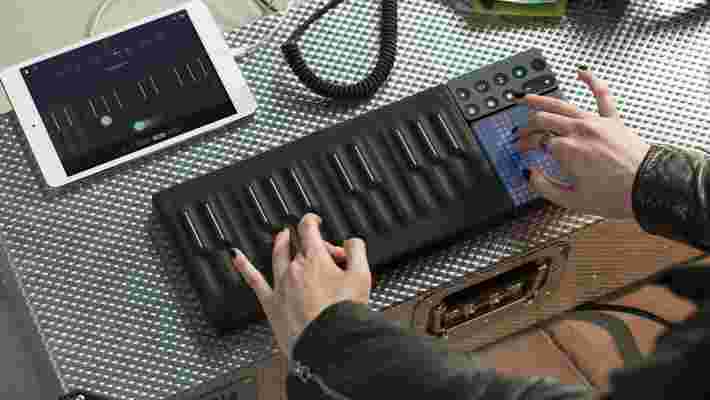Few instruments invented since the turn of the century have garnered as much attention as Roli’s Seaboard line. It’s wavy surface of flexible silicone allowed musicians to modulate and transition between sounds more intuitively than your typical MIDI controller, let alone a traditional piano.

Then last year, Roli expanded on the concept with Blocks . The portable system packed the Seaboard’s technology into modular 4-inch ‘Lightpads’ – which used colorful LEDs to show off customizable note patterns and effects – that were meant to be both affordable and accessible for new musicians.
Now Roli is combining its two product families with the – wait for it – Seaboard Block.
It’s pretty much what you’d imagine; Roli fit a 24-key Seaboard into a Block the size of a few Lightpads. The keys shrank a bit in size, but it allows the system to be super portable and much more affordable.
For reference, the previous smallest Seaboard, the Rise 25, pretty much required a carrying case, and cost $799. The Seaboard Block, on the other hand, would easily fit into a small backpack, and costs $299.
Because the latter are modular, you can stack multiple units to imitate a full-length piano. Heck, maybe you previously had a career as an organist and want three rows of keys – that works too. I got a brief (and impressive) live demo of the new Seaboard. As far as I can tell, it seems just as versatile as its predecessors.
This promo video should give you a good sense of the things it can do:
The company is also introducing a new Touch Block to accompany the Seaboard Block. This essentially replicates the hardware controls available on the Seaboard Rise for adjusting the keyboard’s “expressive behavior” on the fly – things like how much the keyboard reacts to your finger’s horizontal movement or varying levels of pressure. You can control these parameters through Roli’s Noise app too, but hardware controls are probably easier to use.
Like previous Blocks, the Seaboard module can connect to your phone (including some Android devices , at long last) via Bluetooth, and Roli says it will last about 20 hours on a charge. It’s an easy system to lug around and privately work on your compositions in a coffee shop.
And of course, you can combine the Seaboard modules with the rest of the Blocks ecosystem. The size of rig is pretty much only limited by your imagination (and wallet).
It’s worth putting the disclaimer out there that I’m not a professional musician and that my own time with the Blocks have been limited (though I’ve spent a solid amount time with the Rise). I can’t tell you to what degree Blocks are better or worse than all the other MIDI controllers out there, but I can tell you it’s one of the few doesn’t seem totally daunting to this noob.
Granted, I’m also a sucker for modular design , but I’m also well aware it’s prone to failure . Roli seems to have struck a comfortable balance. The flexibility of Blocks makes them accessible to budding musicians, yet able to scale over time as your skill, budget, and/or ambition grows. But even its most basic and affordable form – a single $179 Lightpad – the system remains still quite versatile.
Ultimately, the Seaboard Block is just the latest piece of the puzzle as Roli seeks to expand its audience. It’ll be a very welcome tool for those comfortable with keyboard instruments, but I also appreciate that’s it’s not forced on users who never learned to play the piano. Modular design may be on its last legs among smartphones, but I’m glad to see it still has its place elsewhere in tech.
If you’re interesting in picking up a Seaboard Block, Roli’s opening up pre-orders for the Seaboard Block today, although you’ll have to wait until the end of June to get your hands on one.